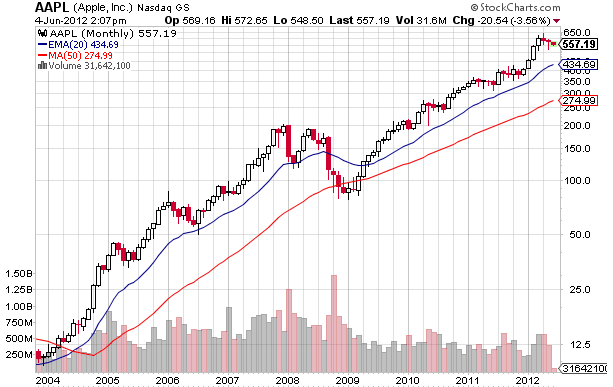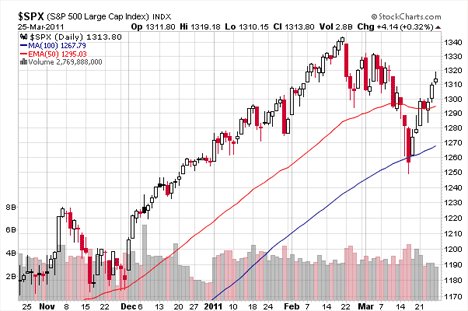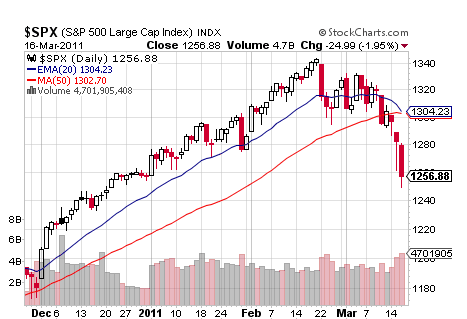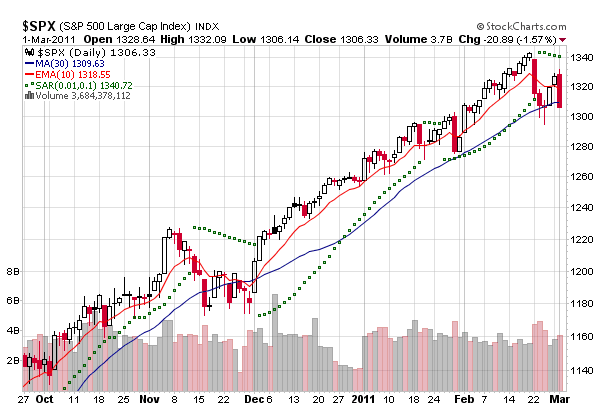Stock Trading Warrior Blog
Information about Today's Stock Market
SPONSOR:
The trend is your friend! Click here to see the Top 50 Trending Stocks.

September 24, 2012
5 Cheap Stocks under $15 - Update
In early May, I happened across an article that recommended some “cheap” stocks that could possibly return over 247% from each one. I proceeded to lampoon most of the picks and I picked out some “non-cheap” stocks of my own to watch as a comparison.
The five cheap stocks listed in the “cheap” article were: ELN, BAC, SD, NAK and RIMM. At the time, I only gave two of them watch list status. The others? Not so much.
The trouble with blind recommendations is that when it comes to stock market investing, simply taking picks from others is dangerous even if the stocks are “cheap.” When investing money, it’s wise to have more in your favor than advice even if the person is positioned as an expert.
The faulty aspect of strictly listening to advice is that many pundits pick stocks based on fundamentals alone and/or economic speculation. Many of them aren’t interested in whether money is actually flowing into those stocks or not. But, I’ll tell you a secret, money flowing into a stock causes the price to rise. You can apply the power of this secret to purchase stocks that will do better than others.
Fundamentals or advice alone aren’t good enough to get you into stocks that will serve your investing needs. To truly succeed, you need to apply trend awareness/following to your investing, which will seriously stack the deck in your favor.
Back in May, when the article came out, I looked at the picks to see if any of them were in a trend or showing signs of starting a new trend. The two I put in a watch list qualified for potential trend picks.
It’s only been four months since the article ran, but here are the performance numbers of the picks from the article:
ELN -12.64%
BAC 19.74%
SD 4.57%
NAK -0.88%
RIMM -45.88%
Out of the list, let’s start with the two stocks I considered possibilities to watch: ELN and BAC.
I wasn’t raising any big flags about ELN at the time, but it had, at least, been in the gentlest of uptrends. However, in July, the price really broke down and it’s now in a downtrend.
BAC was more promising with a very strong up move in price the beginning of this year after years of downward movement. Even though at the time of the first post, it was in a downtrend. It has since perked up quite nicely and is in a possible pull back right now. It was conceivable that it would hit some price resistance. It's still in my watch list.
The losers: SD, NAK and RIMM.
SD hadn’t made any exciting moves until the beginning of September when it started to move upward. If you look at it on a weekly chart it's an unimpressive chart. On a daily chart, it looks like a good stock for short-term scalpers. As for the quick trend upward, it’s now pulled back and may have lost it's steam again.
On the other hand, NAK is showing some signs of life, but it’s still in a long-term downtrend (look at a weekly chart). If it pulls back and then continues to show some life it could be a buy, but stocks that have been this beaten down don’t often rally as well as stocks in a long-term uptrend.
RIMM is the worst pick of all having been in a dramatic down trend for over a year with no reason to believe it was reversing. I seriously hope not one person bought this stock based on plain old advice to buy it.
It’s only been four months since the article ran, but none of the stocks are close to the returns described and some are still going the wrong direction in price!
Then take a look at the stocks I mentioned: KFT, SO, T and VZ.
KFT 7.70%
SO 0.66%
T 17.47%
VZ 12.68%
All of the stocks I picked had been in long-term trends and established a base of which they were possibly breaking out of to the upside. In comparison to the other picks, in the past four months they have done approximately 17% better than the “cheap” picks.
So the term “cheap,” if you choose to simply follow advice, may make you feel like you’re getting a bargain, but in reality you could be losing more monetary value. To avoid the pitfalls of straight advice taking, pick one easy to understand method for
trend following
to apply to your picks and watch your stock portfolio increase.
June 8, 2012
The Facebook IPO
There has been a lot of buzz about the Facebook (FB) initial public offering (IPO) and rightly so. It’s hard to ignore a company going public that has had such a large impact on our social culture. Since it's IPO, FB’s price has been as high as $45.00 and as low as $25.52.
With technology-based IPOs, it’s no surprise that there’s typically a lot of discussion about valuation and Facebook is no different. I happened to turn on MSNBC after the stock went public and listened to one analyst who was talking about a five-year projected FB valuation of $23 per share. That’s in five years! The analyst then took the $23 figure and worked backward with an 11% yearly gain to get a valuation price for today - $13.80. Yikes!
A few days later, I happened to catch another fund manager who is educated about IPOs and positioned in the MSNBC segment as “not recommending FB to her clients.” Her point focuses on what is written in Facebook’s company prospectus or S-1. This is the document filed with the SEC announcing a company’s intent to go public. Her main point for the non-recommendation is that on page two of the document, it states, “Our mission is to make the world more open and connected.” Only further down on the page does it mention that, “Advertisers can engage with more than 900 million monthly active users…” Her point is that most fund managers want to invest in companies that have the focused mission to earn a profit and the intention for how they will do that is expected to show up in the prospectus. She looks for more about what a company “will do” to profit, not what a company “can engage” (in).
Mark Zuckerberg wrote a letter addressing the seemingly “altruistic” mission for FB and you can read it here: Letter from Mark Zuckerberg. Facebook's mission statement, like Apple’s mission statement, is about the “why” of a business. Apple doesn’t just sell computers (although they do), they challenge the status quo in everything they do with their products, and look how that’s turned out. Apple reportedly has over 100 billion dollars in cash and the business originates with the company’s philosophy. Facebook has a similar angle to their purpose for existing. It’s a newer perspective method for the long-term success of a business.
My take is that Mark Zuckerberg is an innovator with a strong inner core of beliefs and I like that, but that alone is not enough for me to buy FB’s stock.
You’ll frequently hear me talk about the “stories” that are told about the companies with stocks trading on the exchanges. Yes, even I can get captivated by a good story. But then I look at a chart. If the story and the chart don’t match up it just doesn’t work as a viable investment. If an optimistic story and the stock’s chart (with an upward trend) match up – it can be magic. Just look at Apple’s (AAPL) 8-year chart:

There are all kinds of "what ifs" and big possibilities. Really big possibilities - especially with Facebook. At Stock Trading Warrior, I use logic and reason for making investment decisions. There’s a difference between something that might be and something that is happening. When I see FB’s price gain some footing it’s likely I will participate, but until then I’m happily on the sidelines.
The bottom line is that the stock market is less than a straightforward animal. Even if you use a valuation method which you think is based on what is really true about a company, there’s still the aspect of humans buying stocks. People have all sorts of perspectives and when a new stock hits the markets, that human psychology is all over the place. If you’re truly interested in an IPO as a stock investment, my recommendation for how to handle them is to let them establish a price base or at least settle down from the initial frenzy. When a clear trend emerges – buy it. It doesn’t make sense to put money into an investment until the price has stabilized from the initial craziness. After that, the sentiment about the stock can be seen in how the price is moving and more solid decisions can be made about whether to invest or not.
Is This the Time to Buy These Stocks?
May 9, 2012
Can I say, hell no!?
I was reading an article the other day about 5 Cheap Stocks Under $15 that are worth looking at and that could rise as much as 236%! After looking at them, I had the exaggerated thought - there’s absolutely no way! And, I feel sorry for anyone who takes that kind of advice at face value and just logs onto a broker account and buys them. I know in my early years of investing I did listen to this kind of rationale and where did it get me? No where! Don't get stuck in this trap.
Think about it. Each stock would have to rise 47% on average to equal 236%. But, that’s not even what the author meant by the article description. The author was stating that all of the stocks could each rise by 70% all the way up to 236%. By when could this possibly occur? We do want to earn gains in our lifetime, don’t we? I know I do.
Alright, let’s get to these five cheap stocks under $15 which are: ELN, BAC, SD, NAK and RIMM.
“Two outa three ain’t bad” as Meatloaf sings, but one and a half outa five is bad.
First, let’s look at the one and a half “possibilities” for upside – ELN and BAC.
ELN has been in a weekly trend for more than a year and if it bounces back up over it’s 50-day moving average it may be continuing its slow uptrend. Slowly. Like a snail.
BAC seemed to be turning upward at the beginning of this year, but has since retraced back down over 20%. It’s possible that BAC is taking a break after the 100% run up it had from December 2011 to March 2012. It’s should be on a watch list for renewed interest (it’s on mine). In general, BAC is a nice easy mover in price and that’s attractive for less risky investors. The current price is below the 50-day moving average and it’s currently in a downtrend. Not a good time to buy – yet.
I would look at BAC if a new uptrend emerges. You know, a trend, where the price is moving up?!
Now for the rest of the group – SD, NAK and RIMM.
SD has been range bound all year so far. If you’re a fan of the
rolling stocks strategy
this has been and could continue to be a good candidate for that strategy. But, get up to the article’s high target of a 145% gain? Hmm. It could, and if it did, it would also be breaking out of a 3-year price range which could attract more buyers and cause the price to keep rising.
NAK and RIMM are excellent examples of down trending stocks. Consider not letting a falling knife bloody your hand.
NAK and RIMM are the stocks that supposedly have the potential to gain 233%-236% based on analysts targets for the stocks because they’re down the most from prior highs.
Gez. Really?
It’s really not fair to any investor to get this kind of advice if there’s the chance that they might actually follow it. But, I’m not saying that these stocks can’t rise to the much higher levels being talked about.
The stories about these companies are great and who doesn’t love a good story? I know I do, but let’s apply some reason here. I invested for a long time listening to other people’s stories and it didn’t serve me very well.
What I found is that I needed a better reason to invest in a stock. A reason (beyond a story) to believe. A way to independently decide if a stock is going to earn me a gain.
The answer is to use some kind of
trend indicator
to see if people are really beginning to have some interest in it. One stock I own and I talk about in the video,
“What Makes a Stock Go Up?”
is Sally Beauty Holding Inc. (SBH). SBH has been in a long-term, gorgeous uptrend.
So are these five stocks really worth looking at buying? Sure, just make sure you have a tangible / material / existing reason for buying which isn’t based on somebody’s story.
Additionally, why limit your investments to stocks below the $15 price point? Take a look at KFT, SO, T or VZ. They’re all in uptrends, breaking out of bases, at or near 52-week highs and some with greater volume. The way these stocks are beginning to perform suggests renewed interest in them. These are what the top performing stocks looked like as they moved along continuing trends and if you find one under $15 – great!
Optimism is a great thing, but I don’t like it for investing my hard-earned money. Eyeballs work well for me.
Return to
Online Stock Trading Warrior Home.
Protesters Occupy Wall Street
5 (Other) Ideas to Battle Corporate Greed
1. Go the Traditional, but More Comfortable Route
I can certainly understand why people are angry over corporate greed, especially when it comes to the perceived imbalance of monetary distribution in our country. However, I still think the right place to protest is in Washington, D.C. - for two reasons. Go the traditional route and meet with representatives to explain the concerns. That's the democratic gift we've been given and think about all the power that wields, right? (Right.) Regardless of our individual power in Washington, to get me on board, I need some solution-oriented comments. It’s too easy to be angry. You may have heard of the Burning Man gathering... how about a Thinking Man gathering followed by a crusade to D.C? A second reason to go the traditional route is creature comforts. Think about how many grassy areas there are in D.C. for protesting and camping around the capital.
2. We Need More Government, Baby
How about campaigning to pump up the S.E.C? (I know, I know – more government? Yes, in all the right places. Talk about checks and balances…) My impression of the S.E.C. is that it’s a sleepy, late-to-the-party organization. It makes me wonder - is it set up that way on purpose? Along with campaigning to strengthen the S.E.C., apply for jobs at the S.E.C. office (in the current incarnation, perfect for protestors standing around not doing too much [audience laugh]). Become the living and breathing corporate greed patrol - that’d be an easy way to fill some of the gaps that the greed mongrels swim in.
3. Facial Hair in Corporate America is In
On the other hand, another way to go is to create a company and become involved in the very thing one opposes – in this case, Corporate America. If one wants to “occupy” Wall Street, my suggestion is to join together and infiltrate through the system itself by creating value in the form of a company and developing a different fiduciary business model. Really occupy Wall Street and kill two birds with one stone - employment and change. Or, work your way up to becoming the CEO of any of the largest companies in the U.S. and distribute the money differently. Lead the way out.
4. Fight for Your Right to…. Party (I mean trade)
Start trading stocks in the Wall Street markets. That’s the thing about the stock markets that can really capture an imagination – they are open markets for anyone to participate. Woah. Or, seek out and recruit the brightest trading minds and develop a “think tank” of traders to develop strategic trading plans. (Count me in on that.) The goal would be to create a bad-ass tank of trading strategies. In theory, wouldn’t that be a way to infiltrate corporate pockets? Remember, stocks go up and they go down. Kind of a "keep your enemies close" idea.
5. Grow Old
I’ve noticed that protesting seems to be mostly for the young. Why is that? As we age do we just get worn down? The themes of protests are typically good rally calls, but maybe with age we work smarter? When I take issue with something, I think about what I want the outcome to be, that then becomes the goal and the resulting actions build up to achieving the goal. Why would I set a goal and then go sit in front of a building? Linear thinking, people.
Yes, "occupy" Wall Street. By all means. Bring your ideas. Put on a suit (if you have to), intern if you have to, learn all about the “system” and work from the inside to create monetary balance. In general, fight the good fight and if satisfaction doesn't come from those efforts, there's always calling into work sick, inviting your friends and hopping on a bus or plane to New York.
It’s easy to be angry. I know. I was young once.

$SPX Bounces Off the 100-Day MA
March 27, 2011
The downward market movement of the $SPX turned into a "V" pattern this week after dipping below the 100-day
moving average
(MA) last week. From it's recent high, the $SPX declined approximately 5.9%. That combined with the dip below the 100-day MA are important signals. The last dip in the $SPX was 3.7% from high to low and only touched the 50-day MA. To summarize, the short-term upward move still leaves room for caution.
As an aside, the
$CPCE
hit a higher point on the put (short) side recently which can be a contrarian signal for the trend to swing back toward increased call (long) positions.
But keep in mind there may be resistance points ahead if the $SPX tries to climb above its recent high.
So if the possibility exists that we may be moving into a range-bound market, what’s your
trading plan?
Do you have a strategy for a range-bound market? One strategy is the
rolling stock strategy,
where trades are made using stochastics and based on a stock's resistance points. I sometimes use this strategy and it has worked successfully in a range-bound market.

Downward Ho!
March 16, 2011
So as I mentioned three weeks ago on February 22, market action signaled a pause in taking long positions. The trend indicators have continued to signal a down trend, but reading the candlesticks it seemed the bulls were trying to push back especially over the last week.
When you see a candlestick that occurred yesterday like this:
It typically implies that the bulls are pushing the bears back and if the prior candlestick is followed by a strong candlestick up day like this:
This is a strong signal on the long side. However, today’s longer red candlestick was almost the opposite of that and the continued downward trend point to the likelihood of more downside.
As for my own portfolios, all but one of my longs are sold, locking in my profits on them. As a trend trader, I let the markets and individual stocks tell me what to do. I don’t have to speculate, I just respond to those messages.
Candlestick reading is a huge visual aid for understanding what is occurring in the markets. A terrific website dedicated to candlesticks is Candlestickler.
Can Anyone Learn How to Trade Well?
March 7, 2011
Is it true that only some people have the aptitude to invest successfully in the stock market? Is there some kind of special ability that one must have to make successful trades?
I don’t believe that. I’m here to say and this website exists to show how anyone can learn how to trade successfully in the stock market.
Is this too large of a claim? There are people in the financial industry that believe not everyone can do this. But, would you let someone tell you that you can’t do something? Or, are you ready to use the stepping stones available to you to become a
Stock Trading Warrior?
Is one born with the aptitude to drive a car? Balance a check book? Cook a meal? We’ve all had the need to do these things and we found a way to do them successfully.
I never believed I couldn’t learn how to trade. It just took time. It’s my goal to use the knowledge I have found to provide a bridge for people who want to be able to trade stocks. Or, if you’re trading today but not as successfully as you would like I hope that you can find where the gaps exist and improve your success ratio.
I just don’t believe that only a special few can trade successfully. What I think is that most people don’t get all the information they need to do well.
The
stock trading systems
or
beginner investor
pages are a great place for a general overview of what stock trading entails.
Thoughts about this topic?
Feel free to weigh in on this subject.
Where Are We Headed?
March 1, 2011

This is what I was afraid of and what I was alluding to on February 22nd - this gorgeous market trend breaking down.
Market trend
is like traffic control in stock trading. It's so important to be aware of the "traffic" flow to increase a trader's or even long-term investor's opportunity for success. Many technical indicators can be adapted for any length of time to line up with a traders preferred holding time for a stock.
I've added a few indicators to the graph above so you can see that the trend may be really breaking down. I've added
Parabolic SAR
and some
moving averages
(EMA 10 day and SMA 30 day). With the PSAR "dot" above the day's bar and the index closing below the 30-day moving average, the current signals indicate to continue to hold off on any long positions and perhaps begin looking at potential shorts.
For now, I'm monitoring my positions - none of which sold out today - and you should do the same.
Fasten your seat belt and let's see what happens!
Nasdaq Composite Down 2.74%
February 22, 2011
What happens in your portfolio on a day like today when the $SPX drops 2.05% and (ouch) $COMPQ has a gap down and drops 2.74%? Is the red dripping off your computer screen? Were orders triggering right and left? What do you think about the carnage? Do you consider it to be any kind of a signal, or do you ignore the downward move and/or your portfolio all together?
Today’s response should be part observation, part action.
For a stock holder, a 2%+ market drop is a strong signal to stop entering into any long positions and tighten stops on current positions. Not entering long positions right now is pretty common sense. You remember the saying, “never try to catch a falling knife,” right? Even if you don’t, please tell me you do. Additionally, tightening stops will prevent too much loss on any gain or loss of capital on recent purchases should the market continue to follow through on the downside. Personally, across several portfolios, I started with 11 positions at the opening today and two sold out based on the stop losses I have in place. After the market has closed, I will reevaluate my stock positions and stops.
Although my positions didn't move dramatically today, I still pay attention to potential shifts in
market direction.
Back in the middle of April of this year, right before the “flash crash” there was this same kind of signal. I never know nor does anyone else really know if the drop is signaling a large reversal or a moderate pullback, but I pay attention and protect myself like I did in May and back in the Fall of 2008.
Tomorrow’s action will provide more information about how folks respond to the action today. If tomorrow moves through the low of today there is a stronger possibility that we have some kind of a pullback occurring.
On a day like today, I also begin looking at short opportunities.
Until tomorrow…
Return to
Online Stock Trading Warrior Home page.











